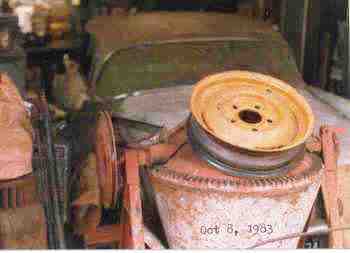
|
We
purchased our 1956 Studebaker Golden Hawk (serial #
6032195, body # 2591, engine # S-2920) from the second
owner on October 8, 1983. Documents received from the
Florida Department of Motor Vehicles, and a copy of the
original production order from Newman & Altman
provided quite a bit of interesting information about
the first Studebaker we have ever owned.
Our car was shipped via Truckaway McDowall to Orlando, Florida on February 15, 1956. The Mocha/Doeskin (paint code P5637) two tone beauty was delivered to Beltz-Beatty Inc., the Studebaker dealer located at 234 Central Avenue in downtown Orlando. I tried to locate the dealership in 1984, but when I got to the general area where the correct street number should have been, I was sitting under Interstate 4. I guess the dealership gave up its existence so that future travelers could sit in traffic jams waiting to get to Walt Disney World. Today, that portion of I-4 is one of the busiest roadways in central Florida. |
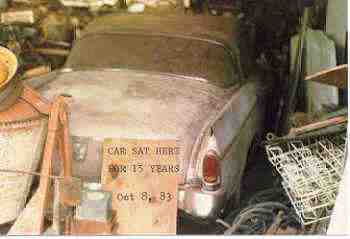
out Tom's garage. |
The car came
equipped with automatic transmission, power steering,
white wall tires, push button radio with internally
controlled antenna, full wheel disks, cigar lighter,
electric clock, back-up lamps, climatizer, directional
signals, and windshield washers.
Apparently no one was interested in the car until Russell M. Sperau of St. Cloud, Florida purchased the Hawk a year and a half later on September 17, 1957. Russell sold the car to Village Motors, 2203 S. Orange Avenue, Orlando on May 8, 1961. It was then purchased by Tom McNutt of Orlando on May 25, 1961. |
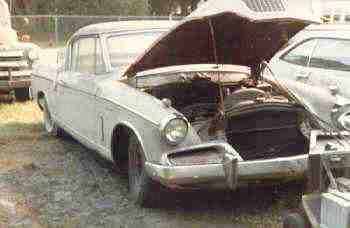
daylight for the first time in 15 years. Believe it or not, we got the engine started in about 10 minutes. |
Tom drove
the car sparingly until 1968 at which time he parked it
in his garage. It sat there for the next 15 years while
Tom piled other accumulated storage items around, on top
of, and under it. We purchased the car from Tom on
October 8, 1983, one year to the day after first talking
with Tom and agreeing to make the purchase. Tom realized
that after 15 years, he probably would never get around
to restoring the car.
The car was virtually buried in Tom's garage and when we initially went to see the car, we could get no closer than about two feet. If you could have seen that sight, you would understand Tom's reluctance to pull the car out and finalize the sale. |
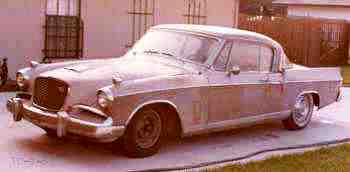
|
I
persevered and finally on that momentous day, he
answered my phone call with the question, "guess what
I'm doing." He had been working on getting the Hawk out
of the garage for about four hours by the time I
arrived. After four more hours, we were ready to tow it
out with his 1953 Dodge Pickup.
That took another 45 minutes as we had to gently
squeeze it past the spare Packard engine/transmission
assembly which was protruding into the passenger side
rear wheel well. Then, after he had moved the full
size diesel bus out of the way, we had to maneuver
around a couple of non running Corvairs, past all the
assorted boxes stacked along side. |
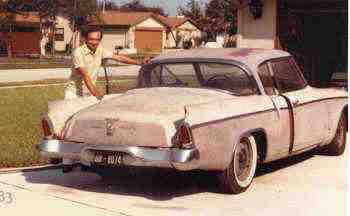
my face, but I'm really wondering what I've gotten myself into. |
I have to admit
I had second thoughts when Tom told me to get in and
steer while he pulled the car from the rear with the
Dodge. The 15 years of sitting, with the driver's side
window half way down, left the interior as dirty as the
exterior. I wasn't sure what kind of reception I was
going to receive from the then current inhabitants.
The Florida Chamber of Commerce propaganda will show
miles of beaches, rows of palm trees, while it raves
about the sunshine. It fails to mention all the little
critters that resent our intrusion into their domain.
As a transplanted Detroiter, I have never quite
adjusted to the sudden appearance of these little
jewels of nature. Happily, nothing |
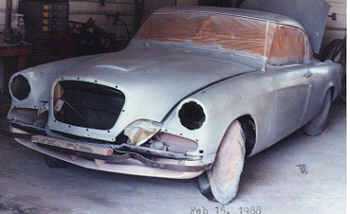
of other things, we finally get down to painting. |
That
previously mentioned sunshine was not present on this
early autumn evening. Instead, the car's first venture
outside in 15 years was greeted by overcast skies and a
slight mist in the air. So much for the Chamber of
Commerce. Tom then did a little tinkering and, using an
auxiliary gas tank and a battery from his lawn mower,
actually got the car started in about 10 minutes. I'm
still not sure if that tingling feeling I had was from
pure joy or if some little critters actually did invade
my hide.
The car was towed home in the dark of night. The next morning I began to doubt my sanity as I looked out the window at this $2000 hulk of weathered metal and rubber. Restoration began shortly afterwards and was completed in 1989 with the addition of chrome valve covers, front seat belts, and a rear seat speaker. This was accomplished at a cost exceeding 10 times the original investment and the question of my sanity is no longer in doubt. Now, I simply refer to the entire restoration process as diarrhea of the wallet. |
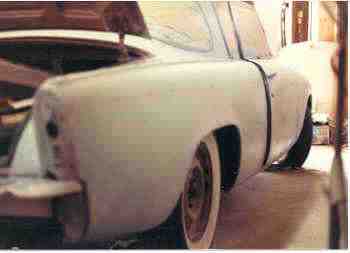
the fins removed and all the body work finished. |
Around 1985, I began corresponding with Don Girvan of Moncton, New Brunswick. His car was identical to ours and we exchanged information through the mail for several years. We discovered that finding Light Rose Mist and Dark Rose Mist interior material was just as futile in Canada as it was in America. Aside from making a new friend, this correspondence with Don spawned a new idea. |
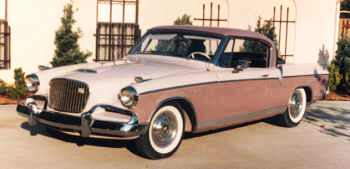
|
One day I thought, wouldn't be nice to be able to correspond with many 1956 Golden Hawk owners who may have solved some of the same problems I had encountered? I placed an ad in the January 1989 Issue of Turning Wheels asking owners to get in touch with me. That was the beginning of the 1956 Studebaker Golden Hawk Owners Register. Membership grew and by late 1995, our total approached 200 members and we had accounted for nearly 300 cars. I maintain a roster of members and vehicles and produce a newsletter every 4 months. |

I decided to buy another one. Pardon Me, Do You Have Any Grey Poupon? |
This Golden Hawk is featured on the cover of the 1956 Studebaker Golden Hawk Parts Catalog, a four year effort which I completed in March 1994. The 320 page catalog contains all the parts used on the 1956 Golden Hawk, along with sections for accessories, service bulletins, and utility items. The format is similar to the Studebaker chassis and body parts catalogs which are currently available from many vendors. Ten years after purchasing the car, I brought it back to Tom's house to show him the results. He was thrilled that I was able put it back in such good condition. Everyone seems to like the car and the color cover of The Catalog is a fitting place for THE CAR THAT LAUNCHED A CLUB. |